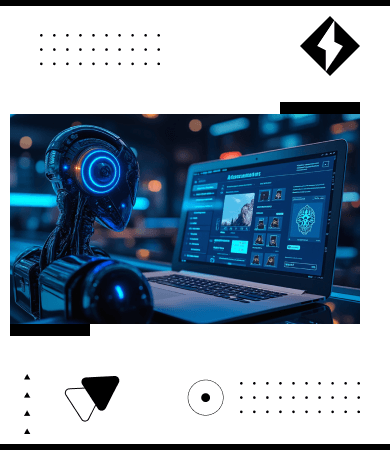Support center +91 97257 89197
Generative AI developmentOctober 8, 2024
AI and the Future of Remote Learning: Enhancing Student Engagement

Introduction
Remote learning has rapidly gained traction, reshaping education at every level. However, despite its advantages—such as flexibility and accessibility—it also comes with significant challenges. Students often struggle to remain engaged, educators grapple with personalization and assessment issues, and many institutions face technological hurdles. This is where Artificial Intelligence (AI) steps in, offering transformative solutions to make remote education more interactive, personalized, and effective.
In this post, we’ll explore how AI is addressing the engagement gap in remote learning, transforming educational practices, and setting the stage for a more connected future in education.
Challenges in Remote Learning
1. Student Disengagement
Remote learning often lacks the personal interaction found in traditional classrooms. Without direct teacher and peer engagement, many students feel isolated and unmotivated. The repetitive structure of virtual classes, combined with the lack of physical interaction, can lead to decreased focus and interest.
2. Personalization Deficit
Traditional online learning models struggle to cater to individual learning styles. Each student has unique needs, ranging from pace to preferred formats, yet most virtual classrooms adopt a one-size-fits-all approach. This limitation can alienate learners who may need tailored support.
3. Assessment Inefficiencies
Assessing student performance remotely is challenging. Educators often rely on tools that either oversimplify evaluations or fail to detect academic dishonesty. This undermines the credibility of assessments and creates gaps in understanding a student’s true progress.
4. Technical Barriers
While remote learning has made education accessible for many, it’s not without obstacles. The digital divide leaves some students unable to participate fully, and even those with access often face technical challenges like connectivity issues or outdated devices.
AI-Powered Solutions to Remote Learning Challenges
1. Intelligent Tutoring Systems
AI-driven platforms like Khan Academy and Coursera leverage intelligent tutoring systems to provide adaptive learning experiences. These tools analyze students' learning behaviors and suggest customized content, ensuring that each student receives a curriculum tailored to their pace and skill level.
For instance, a math tutoring system powered by AI can detect a student’s struggle with algebra and redirect them to foundational topics before advancing to more complex concepts.
2. AI-Driven Engagement Tools
Virtual teaching assistants and chatbots are revolutionizing remote learning. These AI-powered tools can answer common student queries, provide guidance, and ensure round-the-clock support. Platforms incorporating gamification, such as AI-driven quizzes and interactive modules, sustain student interest by making learning more enjoyable.
3. Personalized Learning Plans
AI systems analyze data from assessments, participation, and engagement metrics to create personalized learning plans. A language-learning app like Duolingo uses this approach to provide tailored exercises based on user performance, helping learners achieve fluency at their own pace.
4. Enhanced Assessment Techniques
AI-powered tools simplify grading and enhance accuracy. Automated grading systems evaluate assignments efficiently while detecting patterns of plagiarism. Additionally, some tools use AI to monitor student behavior during exams, ensuring academic integrity.
How AI Enhances Engagement in Remote Learning
1. Interactive Learning Experiences
AI-powered technologies such as Virtual Reality (VR) and Augmented Reality (AR) enable immersive learning. For example, a history lesson might transport students to ancient Rome through a VR simulation, making the experience engaging and memorable. AI adds another layer by adjusting content in real-time based on student interaction.
2. Real-Time Feedback
Feedback plays a critical role in maintaining student engagement. AI tools like Grammarly not only highlight mistakes but also explain the reasoning behind corrections. This instant feedback helps learners understand concepts and apply them immediately, fostering confidence and curiosity.
3. Collaborative AI Tools
AI enhances collaboration in virtual classrooms by facilitating peer-to-peer interactions. Platforms like Edmodo use AI to organize group activities and discussions, ensuring productive collaboration among students. These tools promote a sense of community, countering the isolation often associated with remote learning.
4. Mental Health Support
AI can also address emotional well-being. Tools like Woebot analyze text interactions to detect signs of stress, disengagement, or anxiety, offering timely interventions. By prioritizing mental health, AI ensures students are better equipped to succeed in remote learning environments.
Remote learning has seen explosive growth in recent years, but its rapid adoption has brought numerous challenges to light. Many students find it difficult to stay engaged without physical classrooms, and educators struggle to create personalized, effective virtual learning environments. Thankfully, Artificial Intelligence (AI) is stepping in to revolutionize the way we teach and learn remotely.
By addressing engagement gaps, offering personalized learning experiences, and improving assessment methods, AI is making remote education not just more effective but also more inclusive and engaging. Let’s delve deeper into how AI is shaping the future of remote learning and its implications for students and educators alike.
Challenges in Remote Learning
1. Student Disengagement
The absence of physical interaction can lead to feelings of isolation and boredom. Virtual classes often lack the dynamic energy of a traditional classroom, making it harder for students to remain focused. This disengagement results in lower participation, reduced retention of information, and poor academic outcomes.
2. Personalization Deficit
Every student learns differently, but most remote learning platforms apply uniform teaching methods. This failure to address individual needs makes it difficult for slower learners to keep up, while faster learners may feel unchallenged.
3. Assessment Inefficiencies
Remote learning has made assessments more complex. Traditional methods are often inadequate, leaving room for dishonesty and inaccurate evaluations. Furthermore, without real-time oversight, educators struggle to gauge how well students have understood the material.
4. Technical Barriers
The digital divide continues to be a significant obstacle. Students without access to reliable internet or modern devices are at a severe disadvantage. Even those with adequate resources often face technical glitches that disrupt the learning process.
AI-Powered Solutions to Remote Learning Challenges
1. Intelligent Tutoring Systems
AI enables the creation of adaptive learning platforms that act as personalized tutors. Platforms like Khan Academy use algorithms to analyze students' progress and provide customized lessons. For instance, a student struggling with fractions might receive additional exercises tailored to their level of understanding.
2. AI-Driven Engagement Tools
AI can make remote learning more interactive and exciting. Virtual teaching assistants provide instant support, answering questions or guiding students through difficult concepts. Gamified learning experiences, powered by AI, use challenges, rewards, and progress tracking to motivate students.
3. Personalized Learning Plans
AI systems can create individualized learning roadmaps for each student. For example, Duolingo’s AI-driven exercises adapt in real-time to focus on areas where users need improvement. This approach ensures that learners get the right balance of reinforcement and challenge.
4. Enhanced Assessment Techniques
AI-powered tools simplify grading by automating the evaluation of essays, assignments, and quizzes. Systems like Gradescope use AI to ensure fair and consistent grading while saving educators time. Behavioral monitoring tools also help maintain academic integrity during remote exams.
5. Real-Time Data Insights
AI systems collect and analyze data on student performance, identifying patterns and predicting potential issues. This allows educators to intervene early, offering additional support to students at risk of falling behind.
How AI Enhances Engagement in Remote Learning
1. Interactive Learning Experiences
AI integrates with immersive technologies like Virtual Reality (VR) and Augmented Reality (AR) to create engaging, hands-on experiences. For example, a biology student could explore a 3D model of the human body in VR, while an AI assistant answers their questions in real time.
2. Real-Time Feedback
AI provides instant feedback, enabling students to learn and improve continuously. Writing tools like Grammarly not only identify errors but also explain corrections, helping students develop their skills with every assignment.
3. Collaborative AI Tools
Remote learning often feels isolating, but AI can facilitate collaboration. Platforms like Edmodo use AI to match students with similar interests or group them for projects, fostering teamwork and social interaction in virtual classrooms.
4. Mental Health and Emotional Support
AI is also stepping up to address students’ mental well-being. Tools like Woebot use natural language processing (NLP) to provide emotional support, identifying signs of stress or disengagement. By helping students cope with anxiety and isolation, these tools contribute to a healthier learning environment.
Future Trends in AI and Remote Learning
1. Hybrid Learning Models
The future of education is likely to blend physical and virtual learning environments. AI will play a crucial role in bridging these worlds, enabling seamless transitions between classroom and online learning.
2. Ethics and Data Privacy
As AI becomes more integrated into education, concerns around data security and privacy will intensify. Institutions must adopt robust policies to ensure that student data is protected and used ethically.
3. Co-Creation of Tools
Collaboration between educators and AI developers will lead to the creation of tools that address specific classroom challenges. These co-designed solutions will be tailored to meet the unique needs of diverse student populations.
4. Increased Accessibility
AI has the potential to make education more inclusive by offering tools for students with disabilities, such as speech-to-text systems or AI-generated sign language interpreters.
Case Studies: AI in Action
-
Coursera: This platform uses AI algorithms to recommend courses based on a user’s past behavior and interests. It helps learners discover content that aligns with their goals, increasing completion rates.
-
Khan Academy: With its AI-powered tools, Khan Academy adapts lessons in real-time to suit individual skill levels. Students receive immediate feedback, which helps them grasp complex concepts more effectively.
-
Woebot: Providing mental health support to students, Woebot uses AI to offer daily emotional check-ins, helping students manage stress during challenging academic periods.
AI is not just a tool for improving remote learning—it’s a pathway to transforming education itself. By leveraging AI responsibly, educators and institutions can create learning environments that are inclusive, engaging, and effective.
Ready to explore how AI can enhance your remote learning experience? Start integrating AI-powered tools today and lead the charge toward the future of education
TLDR
AI is reshaping remote learning by addressing engagement issues through intelligent tutoring systems, personalized content, and real-time feedback. These tools not only enhance interaction but also support educators in creating adaptive learning environments. The future of education lies in responsibly integrating AI to make learning more inclusive and effective.
FAQs
Remote learning often faces issues like student disengagement, lack of personalized teaching, assessment difficulties, and technical barriers. These challenges can hinder effective learning and reduce retention.
AI enhances remote learning by providing adaptive content, real-time feedback, virtual teaching assistants, and personalized learning experiences. It addresses individual needs and sustains engagement.
Yes, AI tools can automate grading, detect plagiarism, and monitor behavioral patterns to ensure fair assessments. This reduces the workload for educators and ensures objective evaluations.
Tools like Duolingo, Khan Academy, and Grammarly leverage AI to offer personalized exercises, performance feedback, and language improvements, enhancing the learning experience.
AI-driven tools like Woebot can provide mental health support, identifying signs of stress or disengagement and offering timely assistance to students.
Work with us







